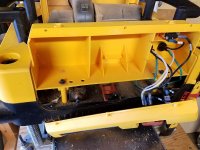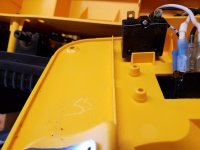ear3
Member
- Joined
- Jul 24, 2014
- Messages
- 4,341
I've started to have real issues with the breaker on my 735 tripping when under load. It only happens when I'm running wider boards (>8"), but I'm not running the machine past it's capabilities in my opinion. We're talking 1/64th passes on the slowest speed with a Shelix cutterhead installed, and when it trips, theres no sound of serious strain that I can discern that would indicate I'm pushing the motor too hard. And given that the problem is a recent development, and has gotten worse over time, I don't know what else to attribute it to (interior is clean, and I keep the bed waxed). The breaker also takes forever to reset, which I've heard is another sign the part might be failing.
It looks like it is a relatively easy install, so I've ordered up a new breaker. There's a video on installing the part, but it's for the 734 -- so my question for those of you who have done this is whether it's basically the same process for the 735?
It looks like it is a relatively easy install, so I've ordered up a new breaker. There's a video on installing the part, but it's for the 734 -- so my question for those of you who have done this is whether it's basically the same process for the 735?


